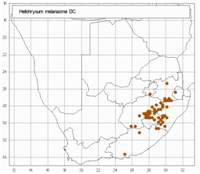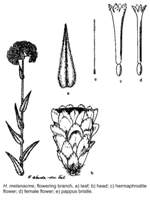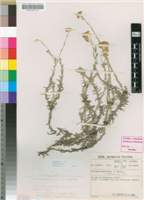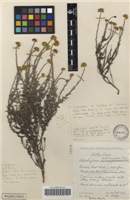Common names:
Hottentotskooigoed (A)
Origin of name:
melan, mel, melano, = black, very dark
Diagnostic characters:
Rather large individual headsStraw-coloured bractsSmall branched open inflorescences with few heads
Description:
A tufted perennial herb or subshrub, stems wiry, branching mostly near the base, decumbent and rooting, then more or less erect to c. 500 mm, thinly greyish-white woolly, closely leafy, more distantly so under the heads. Leaves mostly 8-35 x 1-5 mm, smaller and more distant towards the heads, lanceolate or linear-lanceolate, apex acuminate, base broad, ear-clasping, subdecurrent, margins somewhat revolute, woolly or cobwebby above, thinly white-woolly below. Heads heterogamous, or rarely homogamous, cylindric or narrowly campanulate, c. 3 x 2 mm, many in cymose clusters arranged in a usually compact, sometimes lax, terminal corymbose-panicle. Involucral bracts in c. 4 series, graded, closely imbricate, inner nearly equaling the flowers, tips decidedly crisped, smooth or nearly so, scarcely radiating, tawny (or very rarely the innermost yellowish). Receptacle with fimbrils equaling the ovaries. Flowers (15-) 20-45, 6-18 female, 12-32 homogamous. Achenes c. 0.5 mm long, barrel-shaped, glabrous. Pappus bristles many, about equaling the corolla, scabrid, bases cohering by patent cilia.
Flowering from December to April.
Distribution:
Forms large tangled clumps on grassy mountain slopes or near forest margins. Plants in moist shady places, such as forest margins, have larger and less woolly leaves and are of laxer habit than plants out in the open. Ranges from the mountains about Murraysburg and Graaff-Reinet to the Witteberg near Lady Grey, the Drakensberg and its outliers in East Griqualand, Transkei, Lesotho, Free State and KwaZulu-Natal, the low Drakensberg on the KwaZulu-Natal-Mpumalanga border, and the mountains of western Swaziland; also recorded from Suikerbosrand and Greylingstad on the Highveld.
Grassland and Nama Karoo Biomes.
Notes:
H. melanacme is closely allied to H. tenuiculum but is distinguished by its leaves, which are nearly always woolly or cobwebby above, and its heads with involucral bracts tawny (or very rarely the innermost yellowish), tips always decidedly crisped, and more numerous flowers, (15-) 20-45, 6-18 female, 12-32 homogamous.
Taxonomy:
Literature:
Helichrysum melanacme DC., Prodr. 6: 203 (1838); Harv. in F.C. 3: 246 (1865); Hilliard & Burtt in Notes R. bot. Gdn Edinb. 38: 145 (1980).
Type:
Cape Wittebergen, Dr�ge 5767 (G-DC, holo.).
Synonym(s):
Gnaphalium melanacme (DC.) Sch. Bip. in Bot. Ztg 3: 172 (1845).
Gnaphalium kuntzei O. Kuntze, Rev. Gen. Pl. 3,2: 152 (1898). Helichrysum kuntzei (O. Kuntze) Moeser in Bot. Jb. 44: 279 (1910). Type: Natal, Charlestown, O. Kuntze (K, iso.).
Helichrysum pullulum Burtt Davy in Jl S. Afr. Bot. 1: 109 (1935). Type: Cape [Natal], Umzimkulu River at Handcock's Drift, 2 500 ft., Dec. 1885, Tyson 3086 (K, holo.; Z, iso. Note: the SAM specimen under this number is H. cymosum).
H. tenuiculum sensu Hilliard, Compositae in Natal 169 (1977); non DC.
Vouchers:
Acocks 23609 (PRE); Compton 24827 (NBG; PRE); Devenish 573 (PRE); Hilliard & Burtt 7670 (E; K; MO; NU; S); Schlechter 6501 (BOL).



